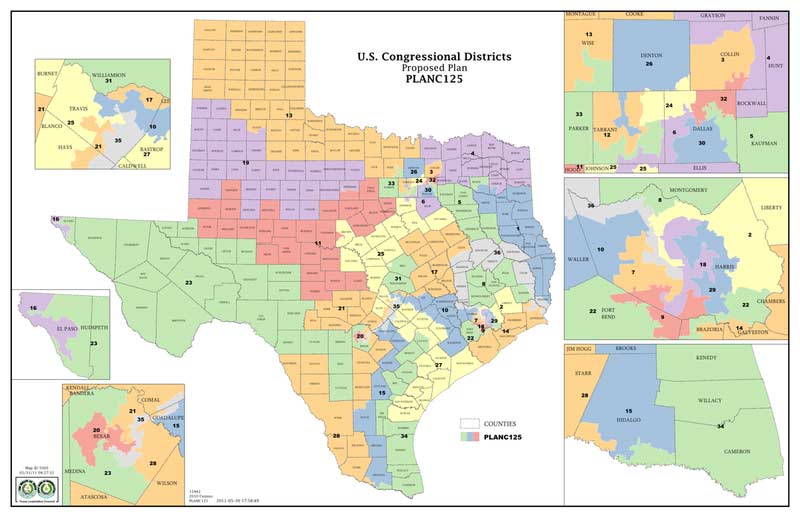
A panel of three federal judges has ruled that Texas’ redistricting plan violates the Voting Rights Act. Texas, because of its history of suppressing minority rights, must have any changes to its election law “pre-cleared” under Section 5 of the Voting Rights Act. D.C. Circuit Judge and George W. Bush appointee Thomas Griffith wrote the opinion, finding that all 3 redistricting plans dilute minority voting power by carving up minority-heavy congressional districts.
Texas’ normal deep red voting pattern was thrown into flux by the exploding population and rapidly shifting demographics in the state. According to the 2010 Census, Latinos comprised two-thirds of the 4.3 million new Texans, while 11 percent are black. Because of this dramatic population growth, Texas was given four more Congressional seats. But when the Republican-controlled Legislature redrew the congressional map to create the new districts, minority Congress members saw their offices carved out of their districts, while white Congress members retained theirs. Judge Griffith found that “substantial surgery” was done to predominantly black districts to cut them off from their representatives’ offices and their strongest fundraising bases, while the districts of white Congress members were either left untouched or were “redrawn to include particular country clubs and, in one case, the school belonging to the incumbent’s grandchildren.” Furthermore, black and Latino representatives were excluded from the map drawing process.
Texas claimed this disparate effect was pure coincidence, but the judges were unconvinced: “We are confident that the mapdrawers can not only draw maps but read them, and the locations of these district offices were not secret.”
The court was also deeply skeptical of the state’s claim that the chief mapdrawer had no idea he used racial data to draw district boundaries:
Texas made [Texas House Republican staffer Gerardo] Interiano’s testimony the cornerstone of its case on purpose in the House Plan. Interiano spent close to a thousand hours…training on the computer program Texas used for redistricting, yet testified that he did not know about the program’s help function, or of its capability to display racial data at the census block level…The implausibility of Interiano’s professed ignorance of these functions suggests that Texas had something to hide in the way it used racial data to draw district lines.
Though Judge Griffith’s opinion will not affect the 2012 race, the court’s finding that the map was drawn with a discriminatory purpose may come into play in the two challenges to the Voting Rights Act before the Supreme Court. The Texas Republicans’ antics in this case could be used as evidence that the jurisdictions covered by Section 5 do still discriminate racially through election law.
We’re not backing down in the face of Trump’s threats.
As Donald Trump is inaugurated a second time, independent media organizations are faced with urgent mandates: Tell the truth more loudly than ever before. Do that work even as our standard modes of distribution (such as social media platforms) are being manipulated and curtailed by forces of fascist repression and ruthless capitalism. Do that work even as journalism and journalists face targeted attacks, including from the government itself. And do that work in community, never forgetting that we’re not shouting into a faceless void – we’re reaching out to real people amid a life-threatening political climate.
Our task is formidable, and it requires us to ground ourselves in our principles, remind ourselves of our utility, dig in and commit.
As a dizzying number of corporate news organizations – either through need or greed – rush to implement new ways to further monetize their content, and others acquiesce to Trump’s wishes, now is a time for movement media-makers to double down on community-first models.
At Truthout, we are reaffirming our commitments on this front: We won’t run ads or have a paywall because we believe that everyone should have access to information, and that access should exist without barriers and free of distractions from craven corporate interests. We recognize the implications for democracy when information-seekers click a link only to find the article trapped behind a paywall or buried on a page with dozens of invasive ads. The laws of capitalism dictate an unending increase in monetization, and much of the media simply follows those laws. Truthout and many of our peers are dedicating ourselves to following other paths – a commitment which feels vital in a moment when corporations are evermore overtly embedded in government.
Over 80 percent of Truthout‘s funding comes from small individual donations from our community of readers, and the remaining 20 percent comes from a handful of social justice-oriented foundations. Over a third of our total budget is supported by recurring monthly donors, many of whom give because they want to help us keep Truthout barrier-free for everyone.
You can help by giving today. Whether you can make a small monthly donation or a larger gift, Truthout only works with your support.